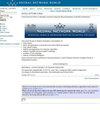Deep multi-modal schizophrenia disorder diagnosis via a GRU-CNN architecture
IF 0.9
4区 计算机科学
Q4 COMPUTER SCIENCE, ARTIFICIAL INTELLIGENCE
引用次数: 1
Abstract
Schizophrenia is a complex mental disorder associated with a change in the functional and structural of the brain. Accurate automatic diagnosis of schizophrenia is crucial and still a challenge. In this paper, we propose an automatic diagnosis of schizophrenia disorder method based on the fusion of different neuroimaging features and a deep learning architecture. We propose a deep-multimodal fusion (DMMF) architecture based on gated recurrent unit (GRU) network and 2D-3D convolutional neural networks (CNN). The DMMF model combines functional connectivity (FC) measures extracted from functional magnetic resonance imaging (fMRI) data and low-level features obtained from fMRI, magnetic resonance imaging (MRI), or diffusion tensor imaging (DTI) data and creates latent and discriminative feature maps for classification. The fusion of ROI-based FC with fractional anisotropy (FA) derived from DTI images achieved state-of-theart diagnosis-accuracy of 99.50% and an area under the curve (AUC) of 99.7% on COBRE dataset. The results are promising for the combination of features. The high accuracy and AUC in our experiments show that the proposed deep learning architecture can extract latent patterns from neuroimaging data and can help to achieve accurate classification of schizophrenia and healthy groups.基于GRU-CNN架构的深度多模态精神分裂症诊断
精神分裂症是一种复杂的精神障碍,与大脑功能和结构的变化有关。准确的精神分裂症自动诊断是至关重要的,但仍然是一个挑战。在本文中,我们提出了一种基于不同神经影像学特征融合和深度学习架构的精神分裂症疾病自动诊断方法。我们提出了一种基于门控循环单元(GRU)网络和2D-3D卷积神经网络(CNN)的深度多模态融合(DMMF)架构。DMMF模型结合了从功能磁共振成像(fMRI)数据中提取的功能连通性(FC)指标和从fMRI、磁共振成像(MRI)或扩散张量成像(DTI)数据中获得的低级特征,并创建了用于分类的潜在和判别特征图。在COBRE数据集上,基于roi的FC与来自DTI图像的分数各向异性(FA)的融合实现了99.50%的状态诊断准确率和99.7%的曲线下面积(AUC)。这些结果对于特征组合来说是有希望的。实验的高准确率和AUC表明,所提出的深度学习架构可以从神经成像数据中提取潜在模式,有助于实现精神分裂症和健康组的准确分类。
本文章由计算机程序翻译,如有差异,请以英文原文为准。
求助全文
约1分钟内获得全文
求助全文
来源期刊

Neural Network World
工程技术-计算机:人工智能
CiteScore
1.80
自引率
0.00%
发文量
0
审稿时长
12 months
期刊介绍:
Neural Network World is a bimonthly journal providing the latest developments in the field of informatics with attention mainly devoted to the problems of:
brain science,
theory and applications of neural networks (both artificial and natural),
fuzzy-neural systems,
methods and applications of evolutionary algorithms,
methods of parallel and mass-parallel computing,
problems of soft-computing,
methods of artificial intelligence.
 求助内容:
求助内容: 应助结果提醒方式:
应助结果提醒方式:


